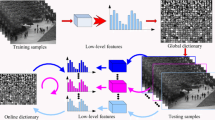Abstract
Anomalies are known as patterns which are not conforming expected structures; therefore, they must be detected to inhibit future hazards. A common method for defect detection in images is background modeling in which characteristics of normal structures are captured and employed for detecting anomalous regions. In this paper, we utilize convolutional sparse representation method for capturing normal structures and feature extractions. Indeed, normal patterns are recorded as atoms of a dictionary in the phase of dictionary learning. Then for abnormality detection, new images are divided into patches, which encompass normal and/ or abnormal structures, and afterwards they are encoded into coefficient maps with respect to the learned dictionary atoms, in the phase of sparse coding technique. Subsequently, coefficient maps are utilized for the purpose of feature extraction and finally, anomaly detection will be done using supervised learning approaches. Simulation results demonstrate remarkable capabilities of the proposed approach. It is worth mentioning that the presented approach leads to higher True Positive Rate (TPR) and lower False Positive Rate (FPR) up to 0.95 and 0.005 respectively in comparison with reviewed methods.








Similar content being viewed by others
Availability of data and material
(data transparency)
Code availability
(software application or custom code)
References
Agrawal S, Agrawal J (2015) Survey on anomaly detection using data mining techniques. Procedia Comput Sci 60:708–713. https://doi.org/10.1016/j.procs.2015.08.220
Aiger D, Talbot H (2010) The phase only transform for unsupervised surface defect detection. In: 2010 IEEE conference on computer vision and pattern recognition, pp. 295-302
Alzubaidi L, Zhang J, Humaidi AJ, al-Dujaili A, Duan Y, al-Shamma O, Santamaría J, Fadhel MA, al-Amidie M, Farhan L (2021) Review of deep learning: concepts, CNN architectures, challenges, applications, future directions. J Big Data 8:53. https://doi.org/10.1186/s40537-021-00444-8
Boracchi G, Carrera D, Wohlberg B (2014) Novelty detection in images by sparse representations. In: 2014 IEEE symposium on intelligent embedded systems, pp. 47-54
Brodatz P (1981) Textures: a photographic album for artists and designers. Peter Smith Publisher, Incorporated
Bruckstein A, Donoho D, Elad M (2009) From sparse solutions of systems of equations to sparse modeling of signals and images. SIAM Rev 51:34–81. https://doi.org/10.1137/060657704
Carrera D, Boracchi D, Foi A, Wohlberg B (2015) Detecting anomalous structures by convolutional sparse models. 2015 International Joint Conference on Neural Networks (IJCNN), Killarney, 2015, pp. 1–8, https://doi.org/10.1109/IJCNN.2015.7280790
Cervantes J, García-Lamont F, Rodríguez L, Lopez-Chau A (2020) A comprehensive survey on support vector machine classification: applications, challenges and trends. Neurocomputing 408:189–215. https://doi.org/10.1016/j.neucom.2019.10.118
Chandola V, Banerjee A, Kumar V (2009) Anomaly detection: a survey. ACM Comput Surv 41:1–58. https://doi.org/10.1145/1541880.1541882
Chen K, Franko K, Sang R (2021) Structured model pruning of convolutional networks on tensor processing units
Davy A, Ehret T, Morel JM, Delbracio M (2018) Reducing anomaly detection in images to detection in noise. In: 2018 IEEE international conference on image processing, pp. 1058-1062
Ehret T, Davy A, Morel J et al (2019) Image anomalies: a review and synthesis of detection methods. J Math Imaging Vis 61:710–743. https://doi.org/10.1007/s10851-019-00885-0
Galerne B, Gousseau Y, Morel J-M (2011) Micro-texture synthesis by phase randomization. Image Process On Line 1:213–237. https://doi.org/10.5201/ipol.2011.ggm_rpn
Gao D, Mahadevan V, Vasconcelos N (2008) The discriminant center-surround hypothesis for bottom-up saliency. In: Advances in Neural Information Processing Systems, pp. 497{504
Grosjean B, Moisan L (2009) A-contrario detectability of spots in textured background. J Math Imaging Vision 33(3):313–337
Li Y (2013) Sparse Representation for Machine Learning. In: Zaïane OR, Zilles S (eds) Advances in Artificial Intelligence. Canadian AI 2013. Lecture notes in computer science, vol 7884. Springer, Berlin. https://doi.org/10.1007/978-3-642-38457-8_38
Mishne G, Cohen I (2014) Multiscale anomaly detection using diffusion maps and saliency score. In: 2014 IEEE international conference on acoustics, speech and signal processing, pp. 2823-2827
Sampath Dakshina Murthy A, Karthikeyan T, Vinoth Kanna R (2021) Gait-based person fall prediction using deep learning approach. Soft Comput. https://doi.org/10.1007/s00500-021-06125-1
SDM A, Karthikeyan T (2020) A wireless IOT system towards gait detection technique using FSR sensor and wearable IOT devices. Inte J Intell Unmanned Syst 8(1):43–54. https://doi.org/10.1108/IJIUS-01-2019-0005
Wohlberg B (2014) Efficient convolutional sparse coding. 2014 IEEE International Conference on Acoustics, Speech And Signal Processing (ICASSP), Florence, 2014, pp. 7173–7177, https://doi.org/10.1109/ICASSP.2014.6854992
Wohlberg B (2017) SPORCO: a Python package for standard and convolutional sparse representations
Zeiler MD, Krishnan D, Taylor GW, Fergus R (2010) Deconvolutional networks. In: Proceedings of the IEEE Conference on Computer Vision and Pattern Recogniti (CVPR), June 2010, pp. 2528–2535. https://doi.org/10.1109/cvpr.2010.5539957
Zontak M, Cohen I (2010) Defect detection in patterned wafers using anisotropic kernels. Mach Vis Appl 21(2):129–141
Funding
The authors did not receive support from any organization for the submitted work.
Author information
Authors and Affiliations
Contributions
(optional: please review the submission guidelines from the journal whether statements are mandatory)
Additional declarations for articles in life science journals that report the results of studies involving humans and/or animals.
Corresponding author
Ethics declarations
Conflicts of interest/competing interests
The authors have no conflicts of interest to declare that are relevant to the content of this article.
Ethics approval
(include appropriate approvals or waivers)
Consent to participate
(include appropriate statements)
Consent for publication
(include appropriate statements)
Please see the relevant sections in the submission guidelines for further information as well as various examples of wording. Please revise/customize the sample statements according to your own needs.
Additional information
Publisher’s note
Springer Nature remains neutral with regard to jurisdictional claims in published maps and institutional affiliations.
Rights and permissions
About this article
Cite this article
Pourhashemi, R., Mahmoudzadeh, E. Supervised anomaly detection by convolutional sparse representation. Multimed Tools Appl 81, 31493–31508 (2022). https://doi.org/10.1007/s11042-022-13020-w
Received:
Revised:
Accepted:
Published:
Issue Date:
DOI: https://doi.org/10.1007/s11042-022-13020-w




